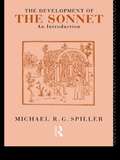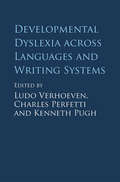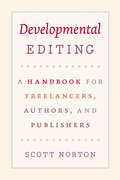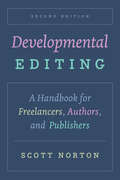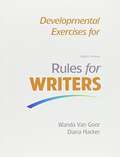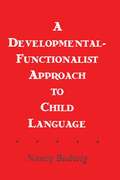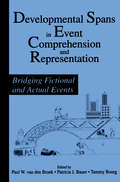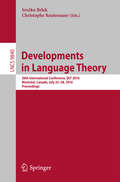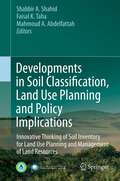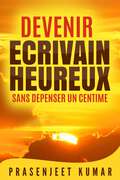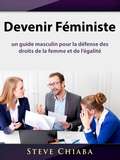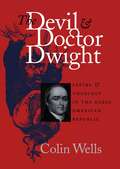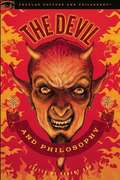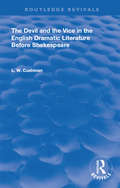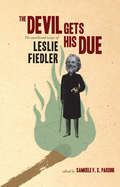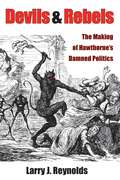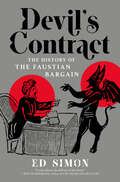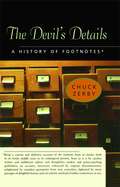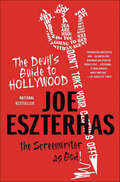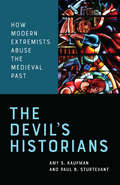- Table View
- List View
The Development of the Sonnet: An Introduction
by Michael R. SpillerFirst published in 1992. Routledge is an imprint of Taylor & Francis, an informa company.
Developmental Dyslexia across Languages and Writing Systems
by Ludo Verhoeven Charles Perfetti Kenneth PughThis volume presents the first truly systematic, multi-disciplinary, and cross-linguistic study of the language and writing system factors affecting the emergence of dyslexia. Bringing together a team of scholars from a wide variety of disciplines, it takes a dual focus on the language-specific properties of dyslexia and on its core components across languages and orthographies, to challenge theories on the nature, identification and prevalence of dyslexia, and to reveal new insights. Part I highlights the nature, identification and prevalence of dyslexia across multiple languages including English, French, Dutch, Czech and Slovakian, Finnish, Arabic, Hebrew, Japanese and Chinese, while Part II takes a cross-linguistic stance on topics such as the nature of dyslexia, the universals that determine relevant precursor measures, competing hypotheses of brain-based deficits, modelling outcomes, etiologies, and intergenerational gene-environment interactions.
Developmental Editing: A Handbook for Freelancers, Authors, and Publishers
by Scott NortonEditing is a tricky business. It requires analytical flair and creative panache, the patience of a saint and the vision of a writer. Transforming a manuscript into a book that edifies, inspires, and sells? That's the job of the developmental editor, whose desk is the first stop for many manuscripts on the road to bookdom-- a route ably mapped out in the pages of Developmental Editing. Author Scott Norton has worked with a diverse range of authors, editors, and publishers, and his handbook provides an approach to developmental editing that is logical, collaborative, humorous, and realistic. He starts with the core tasks of shaping the proposal, finding the hook, and building the narrative or argument, and then turns to the hard work of executing the plan and establishing a style. Developmental Editing includes detailed case studies featuring a variety of nonfiction books-- election-year polemic, popular science, memoir, travel guide-- and authors ranging from first-timer to veteran, journalist to scholar. Handy sidebars offer advice on how to become a developmental editor, create effective illustration programs, and adapt sophisticated fiction techniques (such as point of view, suspense, plotting, character, and setting) to nonfiction writing. Norton's book also provides freelance copy editors with a way to earn higher fees while introducing more creativity into their work lives. It gives acquisitions, marketing, and production staff a vocabulary for diagnosing a manuscript's flaws and techniques for transforming it into a bestseller. And perhaps most importantly, Developmental Editing equips authors with the concrete tools they need to reach their audiences.
Developmental Editing: A Handbook for Freelancers, Authors, and Publishers (Chicago Guides To Writing, Editing, And Ser.)
by Scott NortonThe only guide dedicated solely to developmental editing, now revised and updated with new exercises and a chapter on fiction. Developmental editing—transforming a manuscript into a book that edifies, inspires, and sells—is a special skill, and Scott Norton is one of the best at it. With more than three decades of experience in the field, Norton offers his expert advice on how to approach the task of diagnosing and fixing structural problems with book manuscripts in consultation with authors and publishers. He illustrates these principles through a series of detailed case studies featuring before-and-after tables of contents, samples of edited text, and other materials to make an otherwise invisible process tangible. This revised edition for the first time includes exercises that allow readers to edit sample materials and compare their work with that of an experienced professional as well as a new chapter on the unique challenges of editing fiction. In addition, it features expanded coverage of freelance business arrangements, self-published authors, e-books, content marketing, and more. Whether you are an aspiring or experienced developmental editor or an author who works alongside one, you will benefit from Norton’s accessible, collaborative, and realistic approach and guidance. This handbook offers the concrete and essential tools it takes to help books to find their voice and their audience.
Developmental Editing, Second Edition: A Handbook for Freelancers, Authors, and Publishers (Chicago Guides to Writing, Editing, and Publishing)
by Scott NortonThe only guide dedicated solely to developmental editing, now revised and updated with new exercises and a chapter on fiction. Developmental editing—transforming a manuscript into a book that edifies, inspires, and sells—is a special skill, and Scott Norton is one of the best at it. With more than three decades of experience in the field, Norton offers his expert advice on how to approach the task of diagnosing and fixing structural problems with book manuscripts in consultation with authors and publishers. He illustrates these principles through a series of detailed case studies featuring before-and-after tables of contents, samples of edited text, and other materials to make an otherwise invisible process tangible. This revised edition for the first time includes exercises that allow readers to edit sample materials and compare their work with that of an experienced professional as well as a new chapter on the unique challenges of editing fiction. In addition, it features expanded coverage of freelance business arrangements, self-published authors, e-books, content marketing, and more. Whether you are an aspiring or experienced developmental editor or an author who works alongside one, you will benefit from Norton’s accessible, collaborative, and realistic approach and guidance. This handbook offers the concrete and essential tools it takes to help books to find their voice and their audience.
Developmental Exercises For Rules For Writers
by Diana Hacker Nancy SommersTo learn any skill--whether snowboarding, tennis, CPR, Web design, or the electric guitar--takes practice. Writing well is no exception: In a college composition class, you will learn to write by writing, and you will learn to revise by revising. Developmental Exercises for Rules for Writers, Eighth Edition, will sharpen your revision skills by giving you a great deal of controlled, yet realistic, practice.
A Developmental-functionalist Approach To Child Language
by Nancy BudwigAlthough there has been much empirical study within what has been referred to as "functional approaches to child language," there has yet to be a major attempt to compare and contrast such proposals. In addition, much of the work carried out within child language from a functionalist perspective has not been specific with regard to the nature of the approach adopted. In attempting to fill the gap, the author of this book begins with a comparison of various functionalist approaches. By concentrating on one domain -- agentivity and control -- Budwig develops a set of research questions based on an examination of findings stemming from linguistics, psycholinguistics, and developmental psychology, and also provides an in-depth discussion of related methodological issues. In the second part of the book, she traces the development of linguistic means to refer to oneself within a developmental-functionalist perspective. Individual case studies as well as group analyses of six children in the early phases of acquiring English grammar are provided. In the last part, Budwig examines the relationship between forms and functions in development with special attention to potential generalizations about the organization and reorganization of the children's linguistic systems.
Developmental Spans in Event Comprehension and Representation: Bridging Fictional and Actual Events
by Paul W. van den Broek Patricia J. Bauer Tammy BourgThis book is about building metaphorical bridges--all sorts of bridges. At the most basic level, it concerns the bridges that individuals build to understand the events that they experience--the bridges that connect the events in the mind's eye. At another level, it is about bridges that interconnect findings and theoretical frameworks concerning event comprehension and representation in different age groups, ranging from infancy to adulthood. Finally, it is about building bridges between researchers who share interests, yet may not ordinarily even be aware of each other's work. The success of the book will be measured in terms of the extent to which the contributors have been able to create a picture of the course of development across a wide span in chronological age, and across different types of events, from the fictional to the actual. The individuals whose work is represented in this book conduct their work in a shared environment--they all have an intellectual and scholarly interest in event comprehension and representation. These interests are manifest in the overlapping themes of their work. These include a focus on how people come to temporally integrate individual "snapshots" to form a coherent event that unfolds over time, to understand cause and effect, and to appreciate the role of the goal of events. Another overlapping theme involves the possibility of individual differences. These themes are apparent in work on the early development of representations of specific episodes and autobiographical memories, and comprehension of complex events such as stories involving multiple characters and emotions. The editors of this volume had two missions: * to create a development span by bringing together researchers working from infancy to adulthood, and * to create a bridge between individuals working from within the text comprehension perspective, within the naturalistic perspective, and with laboratory analogues to the naturalistic perspective. Their measure of success will be the extent to which they have been able to create a picture of the course of development across a wide span in chronological age, and across different types of events--from fictional to actual.
Developments in English
by Irma Taavitsainen Merja Kytö Claudia Claridge Jeremy Smith Irma Taavitsainen Merja Kytö Claudia ClaridgeThe history of the English language is a vast and diverse area of research. In this volume, a team of leading historians of English come together to analyse 'real' language, drawing on corpus data to shed new light on long-established issues and debates in the field. Combining synchronic and diachronic analysis, the chapters address the major issues in corpus linguistics – methodological, theoretical and applied – and place special focus on the use of electronic resources in the research of English and the wider field of digital humanities. Topics covered include polemical articles on the optimal use of corpus linguistic methods, macro-level patterns of text and discourse organisation, and micro-features such as interjections and hesitators. Covering Englishes from the past and present, this book is designed specifically for graduate students and researchers working in fields of corpus linguistics, the history of the English language, and historical linguistics.
Developments in Language Theory
by Srečko Brlek Christophe ReutenauerThis book constitutes the proceedings of the 20th International Conference on Developments in Language Theory, DLT 2016, held in Montreal, QC, Canada, in July 2016. The 32 full papers and 4 abstracts of invited papers presented were carefully reviewed and selected from 48 submissions. This volume presents current developments in formal languages and automata, especially from the following topics and areas: combinatorial and algebraic properties of words and languages; grammars, acceptors and transducers for strings, trees, graphs, arrays; algebraic theories for automata and languages; codes; efficient text algorithms; symbolic dynamics; decision problems; relationships to complexity theory and logic; picture description and analysis; polyominoes and bidimentional patterns; cryptography; concurrency; cellular automata; bio-inspried computing; quantum computing.
Developments in Soil Classification, Land Use Planning and Policy Implications
by Faisal K. Taha Mahmoud A. Abdelfattah Shabbir A. ShahidAs the world's population continues to expand, maintaining and indeed increasing agricultural productivity is more important than ever, though it is also more difficult than ever in the face of changing weather patterns that in some cases are leading to aridity and desertification. The absence of scientific soil inventories, especially in arid areas, leads to mistaken decisions about soil use that, in the end, reduce a region's capacity to feed its population, or to guarantee a clean water supply. Greater efficiency in soil use is possible when these resources are properly classified using international standards. Focusing on arid regions, this volume details soil classification from many countries. It is only once this information is properly assimilated by policymakers it becomes a foundation for informed decisions in land use planning for rational and sustainable uses.
Devenir écrivain heureux sans dépenser un centime
by Prasenjeet KumarSoyez un auteur plus heureux avant de devenir un auteur à succès L'auteur de la série "Autoédition sans dépenser un centime" présente ce manuel de bricolage contenant des astuces et des conseils pratiques qui peuvent faire de vous un écrivain plus heureux avant de faire de vous un auteur à succès. En s'appuyant sur son expérience pratique et concrète de la publication de plus de 50 livres en sept langues sur toutes les plateformes de livres électroniques, Prasenjeet Kumar s'attaque à toutes les forces qui conspirent pour vous empêcher, vous l'écrivain, de devenir un grand conteur. Le doute de soi, le manque de ventes, les rejets, les "ateliers" excessifs, la dépendance aux ventes et le sentiment que les lecteurs ne s'intéressent pas à vos livres sont quelques-uns des démons qui peuvent rendre les écrivains mécontents, désespérés et découragés. Avec une grande perspicacité personnelle et professionnelle, Prasenjeet Kumar vous explique comment exorciser ces fantômes et vous transformer en un auteur confiant. Alors venez, réalisez vos rêves d'auteur, avec un état d'esprit plus heureux, et, bien sûr, sans dépenser un centime.
Devenir Féministe: un guide masculin pour la défense des droits de la femme et de l’égalité
by Steve ChiabaUn guide du féminisme moderne pour les hommes Avez-vous déjà été victime de violences, de haine, de harcèlement, ou de souffrances du fait de votre genre ? Être féministe ou pratiquer le féminisme implique de se battre pour des problématiques importantes, comme la parité salariale, le respect, les congés de maternité, les droits liés à la procréation, la violence domestique, etc. Si vous voulez en savoir plus sur la lutte pour vos droits et sur la lutte pour les droits des femmes partout dans le monde, alors ce guide est pour vous. - Apprenez à devenir féministe. - Apprenez à vous battre pour vos droits. - Luttez pour l’équité et la parité salariale. - Et bien plus encore ! Apprenez à être du bon côté de l'histoire en aidant l'humanité là où elle a le plus besoin de vous ! --> Retournez en haut de la page et cliquez sur Ajouter au panier pour le commander dès maintenant Avertissement : Cet auteur ou le(s) titulaire(s) des droits ne revendique, ne promet ni ne garantit l’exactitude, l’exhaustivité ou l’adéquation du contenu de ce livre, et décline expressément toute responsabilité pour les erreurs et omissions qui s’y trouveraient. Ce document est diffusé à titre purement informatif. Veuillez consulter un professionnel avant de prendre toute mesure sur le contenu de ce livre.
Deviant Matter: Ferment, Intoxicants, Jelly, Rot (Sexual Cultures)
by Kyla Wazana TompkinsHow deviant materials figure resistanceYeast ferments, gelatin jiggles, drugs and alcohol froth and bubble, and flesh from animals and plants actively molds and rots. These materials morph through multiple states and phases, and their movement is imbued with a liveliness that is suggestive of volition.Deviant Matter examines four aesthetic and material categories— gelatinousness, fermentation, putrefaction, and intoxication—to theorize how the modern state seeks to manage deviant populations across multiple scales, from the level of the single cell up to the affective and aesthetic imperatives of the state and its bureaucratic projects. Kyla Wazana Tompkins deploys a new materialist engagement with the history of race and queer life, making an argument for queer of color method as political and disciplinary critique. Deviant Matter delves into a vast archive that includes nineteenth-century medical and scientific writing; newspaper comic strips and early film; the Food and Drug Act of 1906; the literature of Martin Delany, Louisa May Alcott and Herman Melville; and twenty-first century queer minoritarian video, installation, and performance art.Drawing from the genealogy of Black feminist and queer of color critique, in Deviant Matter rot, jelly, ferment and intoxicating materials serve as figures for thinking about how matter, art, politics, and affect can be read across multiple scales, ranging from the intimate and molecular everyday to the vast print production and inner workings of the state. Tompkins demonstrates that we are moved by our encounters with the materials in Deviant Matter, producing feelings and sensations that she links to a system of social value where these sensations come to be understood as productive, exciting, disgusting, intoxicating, or even hallucinatory. Moving through multiple states and phase changes, falling apart and reforming again, ferment, rot, intoxicants and jelly energize and choreograph both themselves and human behavior. At the same time, these materialities come to signify exactly those populations whose energy escapes the extractive efforts of capitalism and the state.
The Devil and Doctor Dwight
by Colin WellsAt the close of the eighteenth century, Timothy Dwight--poet, clergyman, and, later, president of Yale College--waged a literary and intellectual war against the forces of "infidelity." The Devil and Doctor Dwight reexamines this episode by focusing on The Triumph of Infidelity (1788), the verse satire that launched Dwight's campaign and, Colin Wells argues, the key to recovering the deeper meaning of the threat of infidelity in the early years of the American Republic. The book also features the first modern, annotated edition of this important but long-overlooked poem.Modeled after Alexander Pope's satiric masterpiece, the Dunciad, Dwight's poem took aim at a number of his contemporaries, but its principal target was Congregationalist Charles Chauncy, author of a controversial treatise asserting "the salvation of all men." To Dwight's mind, a belief in universal salvation issued from the same naive faith in innate human virtue and inevitable progress that governed all forms of Enlightenment thought, political as well as religious. Indeed, in subsequent works he traced with increasing dismay a shift in the idea of universal salvation from a theological doctrine to a political belief and symbol of American national identity. In this light, Dwight's campaign against infidelity must also be seen as an early and prescient critique of the ideological underpinnings of Jeffersonian democracy.
The Devil and Philosophy
by Robert ArpIn The Devil and Philosophy, 34 philosophers explore questions about one of the most recognizable and influential characters (villains?) of all time. From Roman Polanski's The Ninth Gate to J.R.R. Tolkien's The Silmarillion to Bram Stoker's Dracula to Darth Vader to Al Pacino's iconic performance in The Devil's Advocate, this book demonstrates that a little devil goes a long way. From humorous appearances, as in Kevin Smith's film Dogma and Chuck Palahniuk's novels Damned and its sequel Doomed, to more villanous appearances, such as Gabriel Byrne's cold outing as Satan in End of Days, The Devil in Philosophy proves that the Devil comes in many forms.Through the lenses of Jung, Kant, Kundera, Balkan, Plato, Bradwardine, Aristotle, Hume, Blackburn, Descartes, Lavey, Thoreau, and Aquinas, The Devil and Philosophy take a philosophical look at one of time's greatest characters. Are there any good arguments for the actual existence of the Devil? Does demonic evil thrive in Gotham City? Can humans really be accountable for all evil? Which truths about the Devil are actual facts? Is Milton correct, in that the Devil believes he is doing good?
The Devil and the Vice in the English Dramatic Literature Before Shakespeare (Routledge Revivals)
by L. W. CushmanOriginally published in 1900, this book was the first investigation of the devil and the Vice as dramatic figures, and a study of these figures led to a new view of the subject: it is, in brief, that the appearance of the devil in the non-dramatic as well as in the dramatic literature is limited to a definite range. As a dramatic figure the devil falls more and more into the background and the Vice is distinct in origin and function from the devil.
The Devil Gets His Due: The Uncollected Essays of Leslie Fiedler
by Leslie FiedlerDespite his often-unacknowledged influence, academics, intellectuals, and the general audience in America and abroad still read Leslie Fiedler’s work and draw on its concepts. He inspired both reverence (Leonard Cohen penned: "leaning over the American moonlight / like the shyest gargoyle / who will not become angry or old") and rage (Saul Bellow called him "the worst fucking thing that ever happened to American literature"). The essays in The Devil Gets His Due will reacquaint readers with the depth and breadth of Fiedler’s achievements. Tackling subjects ranging wildly from Dante, Ezra Pound, and Mary McCarthy to Rambo, Iwo Jima, and Jerry Lewis, these writings showcase Fiedler’s pioneering of an egalitarian canon that encompassed both "high" and popular literature, cinema, and history. As such, they show a powerful mind critiquing whole aspects of a culture and uncovering lessons therein that remain timely today. A lengthy introduction by Professor Samuele F. S. Pardini offers both context and history, with an in-depth profile of Fiedler and his career as both a literary critic and a public intellectual.
Devil In The Drain
by Daniel Pinkwater"For a long time, I knew that the devil lived inside our plumbing. I could hear him making noises, especially down the drain of the kitchen sink. ..."
The Devils and Canon Barham: Ten Essays on Poets, Novelists and Monsters
by Edmund Wilson Leon EdelThe book takes its title from the scene of Lenin's arrival from Germany in April 1917, ready to take over the leadership of the Russian Revolution and in doing so bring to a climax the political and intellectual movements which are the subject of this study.
Devils and Rebels: The Making of Hawthorne's Damned Politics
by Larry J. ReynoldsWidely condemned even in his own time, Nathaniel Hawthorne's views on abolitionism and slavery are today frequently characterized by scholars as morally reprehensible. Devils and Rebels explores the historical and biographical record to reveal striking evidence of the author's true political values---values grounded in pacifism and resistant to the kind of binary thinking that could lead to violence and war. With fresh readings of Hawthorne's four major romances and his less familiar works, Devils and Rebels illuminates the difficulties faced by public intellectuals during times of political strife---an issue as relevant today as it was some 150 years ago.
Devil's Contract: The History of the Faustian Bargain
by Ed SimonA devilishly fascinating tour of the Faustian bargain through the ages, from brimstone to blues and beyond ...From ancient times to the modern world, the idea of the Faustian bargain—the exchange of one's soul in return for untold riches and power—has exerted a magnetic pull upon our collective imaginations.Scholar Ed Simon takes us on a historical tour of the Faustian bargain, from the Bible to blues, and illustrates how the impulse fto sacrifice our principles in exchange for power is present in all kinds of social ills, from colonialism to nuclear warfare, from social media to climate change to AI, and beyond. In doing so, Simon conveys just how much the Faustian bargain shows us about power and evil ... and ourselves.
The Devil's Details
by Chuck ZerbyFootnotes have not had it easy. Their dominance of eighteenth- and nineteenth- century literature and scholarship was both hard-won -- following many years of struggle -- and doomed, as it led to belittlement in the twentieth century. InThe Devil's Details,Chuck Zerby playfully explores footnotes' long and illustrious history and makes a clarion call to save them from the new world of the Internet and hypertext. In a story that boasts a marvelous plot and a rogues' gallery of players, Zerby examines traditional footnotes and their less-buttoned-down incarnations, as when used by pornographers. Yes,The Devil's Detailsis full of surprises: Zerby hunts down the first bona fide fully functioning footnote; unearths a multivolume history of Northumberland County, England, that uses one volume for a single footnote; and uncovers a murder plot. He even explains why footnotes are like blind dates. Carefully researched and highly opinionated,The Devil's Detailsaffirms that delight in reading can come from unexpected places.
The Devil's Guide to Hollywood: The Screenwriter as God!
by Joe EszterhasIn The Devil's Guide to Hollywood, bestselling author and legendary bad-boy screenwriter Joe Eszterhas tells everything he knows about the industry, its players and screenwriting itself—from the first blank sheet of paper in the Olivetti to the size of the credit on the one-sheet. "There's just one hunk of funny anecdote after another, quotes from everyone who ever mattered in the movie biz, and the thing is jam-packed with screenwriterly advice. Plus it's hilariously funny, ribald, sexy and brilliant."—Liz SmithOften practical and always entertaining, The Devil's Guide to Hollywood distills everything one of Hollywood's most accomplished screenwriters knows about the business, from writing advice to negotiation tricks, from the wisdom of past players to the feuds of current ones. Eszterhas has selected his personal pantheon of the most loved and loathed players in the business and treats the reader to a treasure trove of stories, quotes and wisdom from those luminaries, who include William Goldman (loathes) and Zsa Zsa Gabor (loves). The Devil's Guide to Hollywood could only have been written by someone who loves the business as much as Eszterhas does—but who also has its number."Eszterhas delivers a dishy, catty mix of reminiscences and Hollywood trivia…his forte is skewering sycophants and phonies in this opinionated showcase of the underside of Hollywood life."—Publishers Weekly
The Devil’s Historians: How Modern Extremists Abuse the Medieval Past
by Amy Kaufman Paul SturtevantAmy S. Kaufman and Paul B. Sturtevant examine the many ways in which the medieval past has been manipulated to promote discrimination, oppression, and murder. Tracing the fetish for “medieval times” behind toxic ideologies like nationalism, antisemitism, Islamophobia, misogyny, and white supremacy, Kaufman and Sturtevant show us how the Middle Ages have been twisted for political purposes in every century that followed. The Devil’s Historians casts aside the myth of an oppressive, patriarchal medieval monoculture and reveals a medieval world not often shown in popular culture: one that is diverse, thriving, courageous, compelling, and complex.
